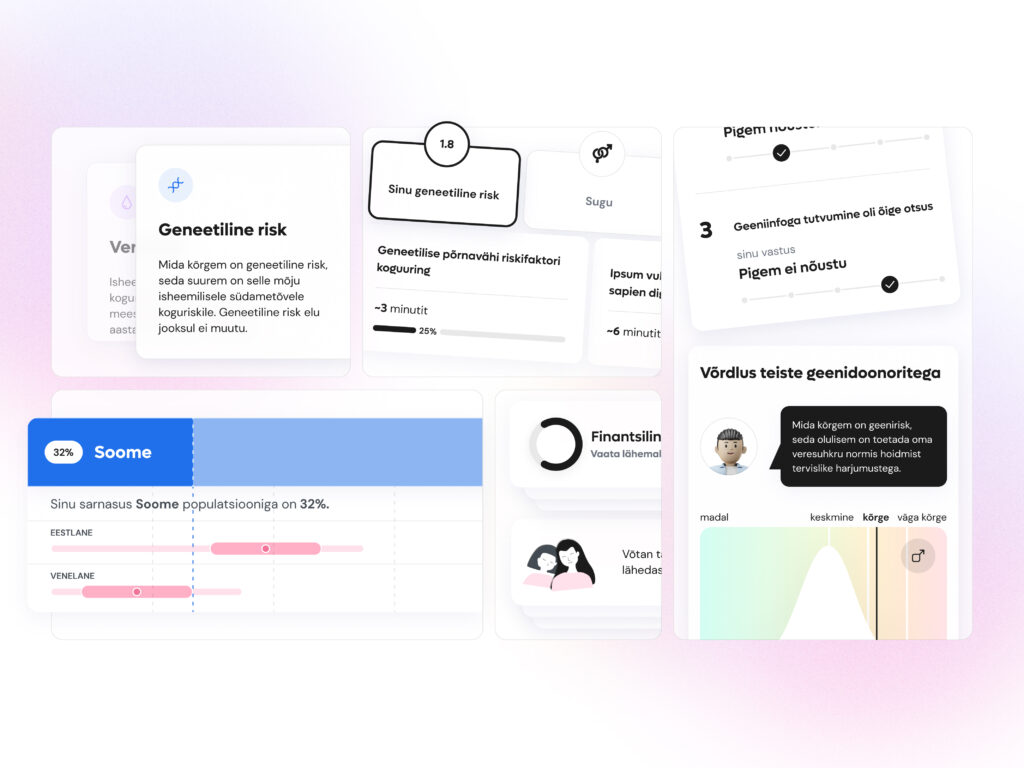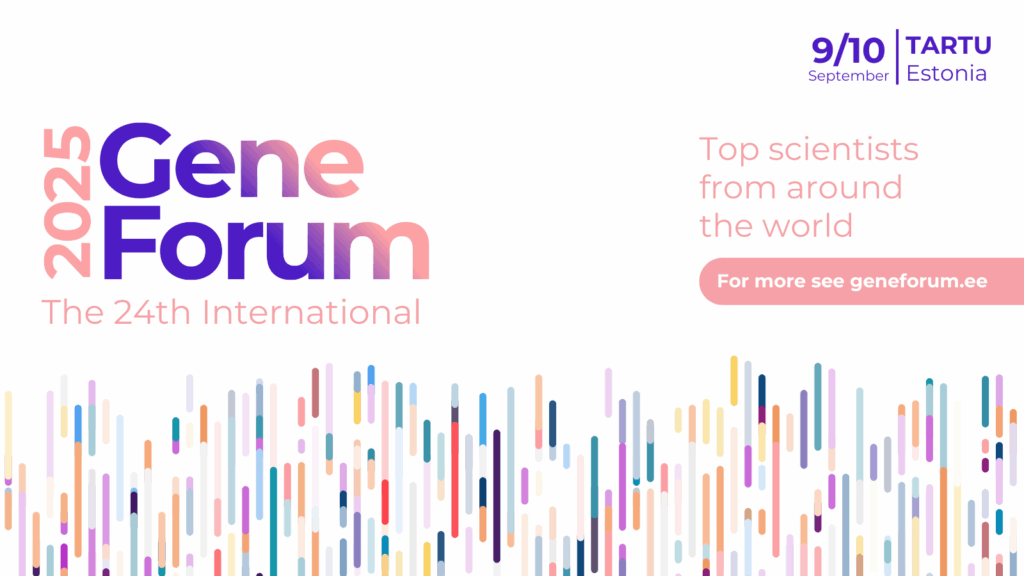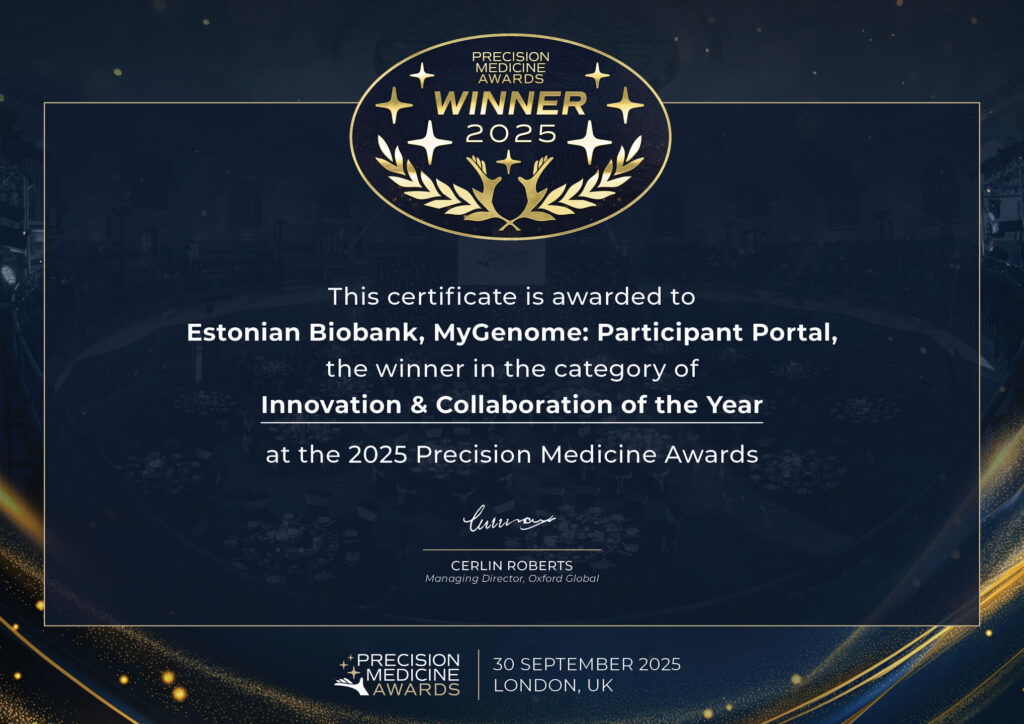A bidirectional model for genomic research in the Estonian Biobank
Biobanks worldwide are moving beyond sample collection toward models that directly inform health care and research. The recent Nature Communications article, The Estonian Biobank’s journey from biobanking to personalized medicine, describes how Estonia has pioneered this transition—linking genomic data with clinical practice, exploring new ways of engaging participants, and setting an example for how population-based resources can drive personalized medicine.
The Estonian Biobank (EstBB), a national initiative based at the University of Tartu, has become a recognised resource for research and innovation in human genomics. It has enrolled over 20% of Estonia’s adult population (212,000 participants)—and combines biological specimens with clinical, health, omics and lifestyle data. EstBB data has been used in more than 800 scientific publications.

What distinguishes the EstBB internationally is its translational focus and long-term engagement with participants. The biobank supports clinical studies based on genetic findings, enables recall of individuals by genotype and explores the effects of returning results. Through the recently launched MyGenome Portal, participants can access selected genomic information, with options to give dynamic consent and personalise the types of results they receive. Together, this marks a shift from one-way data collection to a bidirectional relationship with participants—supporting ongoing research, clinical studies and broader public health goals.
Engaging participants for further research
The recall-by-genotype approach allows EstBB researchers to identify individuals carrying specific genetic variants of interest and invite them for follow-up studies or confirmatory clinical evaluation. Over the past decade, recall-by-genotypebeen implemented for variants linked to several conditions, including familial hypercholesterolaemia, hereditary breast and ovarian cancer and Wilson’s disease. In one study, participants carrying pathogenic or likely pathogenic variants in genes such as LDLR, APOB or PCSK9 were contacted and evaluated clinically. A diagnosis of familial hypercholesterolaemia was confirmed in 86% of cases, many of whom had not been previously diagnosed.
A similar recall initiative involving BRCA1 and BRCA2 variant carriers led to several early breast cancer diagnoses—cases that likely would have gone undetected until later stages under the country’s standard screening programme. Another study focused on ATP7B variants associated with Wilson’s disease. Among participants with two predicted deleterious variants, 74% exhibited at least one related clinical symptom. These findings underscore the potential of genotype-driven recall to improve early identification and, when applicable, facilitate preventive or therapeutic interventions.

According to Dr Lili Milani, Head of the Estonian Biobank, participant re-contact is a central pillar of the biobank’s research model. “Participant recall enables us to bridge the gap between genetic research and medical action. It allows us to explore the potential clinical implications of genetic variation, particularly in cases where evidence supports early detection or preventive intervention,” says Milani.
Every recall study is conducted under a separate ethics approval, with clinical-grade confirmation of high impact genetic findings and appropriate referral pathways established. Such studies would not be possible without a strong collaboration with clinicians – from cardiologist and oncologists to clinical pharmacologists and family doctors. Participant feedback across these projects has been overwhelmingly positive. Most individuals appreciated receiving genetic information and follow-up evaluations suggest that result disclosure did not lead to significant distress.
The MyGenome portal: return of results at scale
In early 2024, the Estonian Biobank launched the MyGenome Portal, a secure web-based platform that allows participants to access selected personal genomic reports. Developed internally and integrated with Estonia’s national electronic ID system, the portal provides information on polygenic risk scores for type 2 diabetes and cardiovascular disease, pharmacogenetic data for selected medications, and trait-level results such as caffeine metabolism and ancestry composition.
To access their results, participants log in using a secure ID and provide dynamic consent. This allows individuals to choose which types of information they wish to receive and to update those preferences over time. The interface includes interactive visual tools to explore how changes in lifestyle factors such as smoking or weight may influence disease risk in combination with genetic predisposition.
Currently, the portal includes only results that are well supported by scientific evidence and are straightforward to interpret. It does not return secondary findings or results of uncertain significance. For more clinically significant or potentially sensitive information, EstBB uses in-person counselling protocols as part of its ethics-approved study designs, with results disclosed by trained professionals.
By early 2025, more than 100,000 participants had accessed the portal. The overall feedback has been positive, with many expressing interest in seeing additional types of results in the future. One of the aims of the portal is to support healthier behaviour by providing information that may help reduce the risk of common diseases. EstBB remains open to expanding the scope of the portal as evidence and resources allow.
A deep and connected dataset
Beyond participant interaction, EstBB’s value lies in the scale, depth and integration of its underlying data infrastructure.It is among the few population biobanks globally to combine comprehensive multi-omics profiling with nationwide electronic health records from both primary and secondary care. These records, dating back to 2004, include diagnostic codes, laboratory results, prescriptions and clinical procedures—totalling over 127 million clinical measurements and 29 million prescription entries. Genotyping has been performed for the entire cohort, with whole-genome sequencing in 2,800 participants and whole-exome sequencing in 2,500. Long-read sequencing of 10,000 additional whole genomes is currently on-going, aiming for completion in 2026. Additional molecular data include proteomics, metabolomics, microbiome profiling, DNA methylation and RNA sequencing. Questionnaire-based data further capture lifestyle, personality, reproductive history, mental health and adverse events from medicine and vaccines.
A distinctive feature of the Estonian cohort is its high degree of genetic relatedness. Approximately 90% of participants have at least one close relative within the biobank. This relatedness enhances statistical power, improves haplotype phasing and imputation and facilitates rare variant discovery. Estonia’s population structure—intermediate between Nordic and Central European groups—adds further comparative value in trans-ethnic genetic studies and fine-mapping analyses.
Safeguarding trust: ethics and data security
The growing complexity and personal relevance of biobank data raises important questions about data security and ethical oversight. EstBB operates under a national legal framework that ensures responsible data access and privacy protection. Before any free-text health data, such as imaging reports or clinical summaries, is made available to researchers, it is processed using an in-house anonymisation tool to remove potentially identifying information. All data used in research is pseudonymised, and access is granted only to approved investigators following a structured application process.
The MyGenome Portal is embedded in Estonia’s national e-ID infrastructure, which enables secure and verified identity authentication. Dynamic consent ensures that participants retain control over what types of results they choose to receive. These measures aim to support both scientific integrity and participant privacy in a responsible manner.
Milani emphasises that data return is handled with care and deliberation. Ethical oversight is built into every stage of the biobank’s operations, from participant recruitment to result disclosure.
Sustaining public participation
Public support for EstBB remains high, with surveys showing that 70% of Estonians approve of the biobank’s mission and 80% are aware of its role in national research. This trust has enabled EstBB to maintain long-term engagement, including plans for a third recruitment wave following the portal’s launch.
The Estonian Biobank provides an example of how population-based research can evolve from passive data collection to a more reciprocal, bidirectional model built on trust. As genomics becomes increasingly relevant to both personal and public health, the Estonian experience suggests that progress will depend not only on the scale of data but also on its depth—supported by clear communication, sustained engagement, and long-term research relationships.





